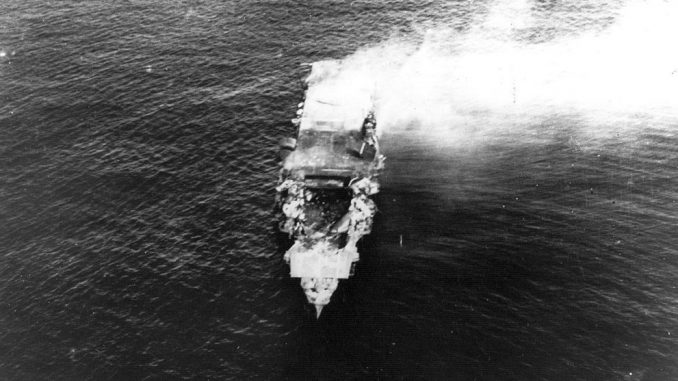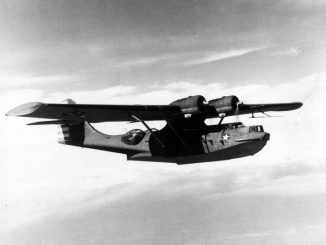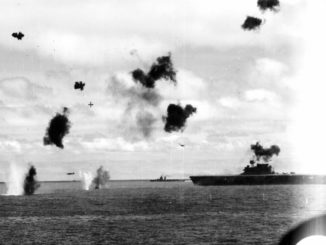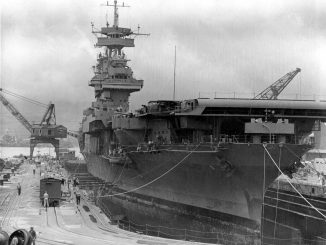
Just before noon, and before the Japanese began their attacks on her, the Yorktown had launched a search mission consisting of 10 SBD Dauntlesses. After almost three hours one of these aircraft came across the Hiryū, at 1445 – just as the Yorktown was being attacked by Tomonaga’s torpedo pilots. Lt Sam Adams, of Yorktown’s own VS-5, plotted the position of the Hiryū as about 110 miles distant from his start point. Admiral Spruance and his staff on the Enterprise received the position report and quickly prepared to launch a strike force of 25 bomb-armed SBDs from three squadrons, which would not be provide with an escort – defence of the fleet was to take priority and the precious F4Fs could not be spared. Nor would any of the three remaining TBDs be included, it being now obvious that flying them against determined opposition was a death sentence for their crews. Meanwhile the Hornet had copied the sighting report and had prepared a strike of her own, but she did not receive any orders to launch until the Enterprise was already sending off her bombers.
The Enterprise formation included SBDs from VB-6 and VS-6, as well as 14 from Yorktown’s VB-3 which had taken refuge with Task Force 16 after the morning strike. These SBDs were launched at 1525 just as the Hornet was belatedly informed that she too should launch a strike. Having ‘broken the spot’ in order to land SBDs that had returned form Midway following their failure to find the enemy during the morning strike, the Hornet air group was unable to comply. As a result the Hornet could only launch her strike of 16 SBDs 30 minutes after that of the Enterprise, eliminating the possibility of the two air groups conducted a coordinated strike.
Rear Admiral Yamaguchi, still temporarily in command of the Kido Butai, was himself planning a third strike on the Americans. By this time the only air strength remaining to him were 6 D3As and 9 Zeros, plus however many aircraft returned from Tomonaga’s torpedo attack. In the end 5 B5Ns made it back to the Hiryū, but only one was deemed serviceable. However, time was rapidly running out for the last Japanese carrier and she would ultimately not be able to launch any more aircraft before the Americans found her.
On the way to the Hiryū, the American noted the smoke plumes from the three carriers which had been hit earlier in the day. At 1620 Gallaher of VS-6 from the Enterprise Air Group spotted the Hiryū at a distance of about 30 miles, and worked around the southeast so as to attack out of the sun whilst also climbing. Just before 1700 the SBDs were in position to attack from 19,000ft. Gallaher elected to attack the Hiryū himself and ordered Lt Dewitt C. Shumway’s VB-3 to attack the Haruna, one of two nearby battleships.
The incoming SBDs were not spotted by either combat air patrol or lookouts, and the Americans achieved complete surprise. The cruiser Chikuma was the first to sound the alarm just a few minutes before the attack began, firing her anti-aircraft guns in the direction of the attackers to alert the airborne fighters, but the dive bombers were only a few moments from tip-over leaving no time for an effective defence. Nevertheless, the few Japanese fighters within range moved in to defend their carrier.
The 14 Zeros on patrol above the carrier responded quickly and efficiently, attacking the SBDs just as they began to dive in. They harassed the Americans all the way down, and had a telling effect on the accuracy of the attack – the first two bombs missed as the Hiryū turned away to port. Seeing these misses Shumway, still on his way towards the Haruna but watching Gallaher’s attack intently, opted to abandon his attack on the battleship and instead led his men over the Hiryū, concentrating on the most important target.
The American attack was disorganised, with different squadrons attacking from different directions and Japanese fighters also in the mix. VB-3, having shifted targets to the Hiryū, got in the way of the SBDs of VB-6. Nevertheless, bombs soon began to find their mark on the Hiryū. The first landed near the forward elevator, which was tossed into the air by the subsequent detonation and thrown against the carrier’s island structure. This was soon followed by three more, all of which landed in the forward part of the flight deck. These completely destroyed the forward area of the Hiryū whilst below explosions gutted the hangar deck and started intense fires, destroying several aircraft parked there. The last available Japanese flight deck had been permanently closed.
Three SBDs were shot down during the afternoon’s attack. One from VB-6 was badly damaged by Zeros before diving, and never pulled out. Two SBDs from VB-3 were lost, one clobbered by fighters at high-altitude just before push-over, the other following the conclusion of the attack. None of the crew were recovered. Two VB-3 aircraft elected to attack their original target, the Haruna, but they failed to land a hit. The Hornet Air Group arrived 15 minutes later but found the Hiryū a burning wreck not worthy of any more attention. Instead VB-8 attacked the cruiser Tone but only registered a pair of near-misses, compounding the Hornet Air Group’s miserable day. Finally, 12 B-17s from Midway arrived and bombed some of the escorts but failed to hit anything.
The strike force began to arrive back in the vicinity of Task Force 16 around 1820, and all were safely back aboard ship within the hour. And so ended the US Navy’s day of days. 80 aircraft from the three carriers had been lost along with over 100 aviators, and one of the precious flat-tops itself would soon slip under the waves. Several other men bobbed about on life-rafts, hoping for rescue – some in vain. But the heart of the Japanese Navy had been ripped out, with two thirds of the Kido Butai – four carriers – sunk in a single day, taking all of their aircraft and many well-trained, experienced aviators with them. There were several days of fighting before the Battle of Midway would be concluded, but by the time the Hiryū was hit it was clear that the Americans had won the day.





Leave a Reply